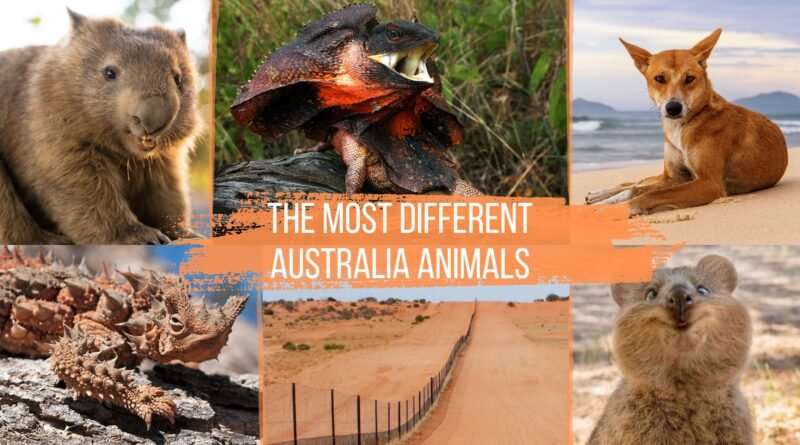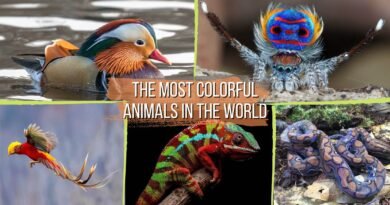The most different Australia animals
Some of the strangest and most unusual animals in the world are located in Australia, and that might not come as a surprise to you. In this article, we will get to know some of them and also talk a little about the particularities of Oceania’s fauna and what makes it so special. Let’s go! Enjoy the article and have fun!
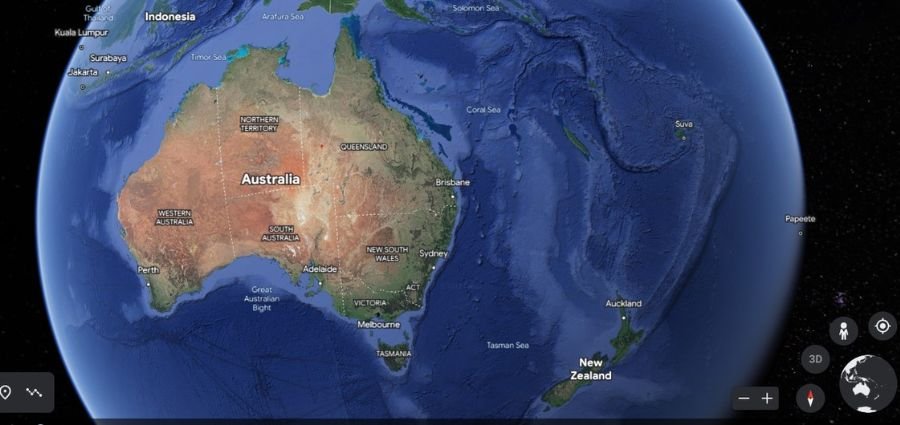
Oceania
Oceania is a continent made up of 14 countries and islands, including Australia, located between the Pacific and Indian Oceans, in Southeast Asia. In it, there are still territories belonging to other nations. It is the smallest continent on the planet and its climates vary from large desert areas to temperate forests.
Also known as the New World, Oceania has been geographically isolated from the rest of the world since the separation of the Gondwana continent, which occurred about 550 million years ago. And this total continental isolation is one of the reasons that experts point out as being responsible for the diversity and appearance of its animals, which is not observed anywhere else in the world.
Some curiosities about Oceania’s fauna:
- more than 80% of the animals are endemic (exist only there);
- owns 10% of the world’s biodiversity;
- more than 1 million different species from the rest of the world;
- Australia is the only country in the world where there are more venomous than non-venomous snakes;
- Australia is the country in the world with the most lizards: a total of 114 species;
- many Australia animals could live in Brazil, as they would adapt perfectly to that climate, which is very similar.
What an interesting continent, isn’t it?! Let’s now meet some different animals that exist only there!
Australia animals
Some Australia animals may even be quite common for us, as they are often shown in movies or television programs. The koala and the kangaroo are examples of this, and the latter is even the country’s symbol animal. Let’s meet some not-so-well-known, right? Let’s go!

Quokka (Setonix brachyurus)
If you surf the internet, you’ve certainly seen this smiley face there. This is Quokka, famous for seeming to love taking selfies and known as the happiest animal in the world as it always seems to be smiling. It only has two small teeth in the front of its jaw, which makes it even cuter.
Quokka is a marsupial mammal, the only member of the genus Setonix, with nocturnal habits and herbivorous. With brown fur, it weighs from 5.5 to 11 pounds and is between 15 to 21 inches long. It is similar in size to a domestic kitten and looks like a miniature kangaroo. When running, it makes small jumps, very similar to its marsupial cousin, but unlike kangaroos, the quokka can climb bushes and small trees.
Their average lifespan is 10 years and they live in Western Australia, more specifically on the islands known as “quokka islands”: Bald Island and Rottnest Island. This is an endemic Australia animal, that is, it does not exist naturally in other parts of the world. And the bad news: it is classified as vulnerable, according to The International Union for Conservation of Nature (IUCN) Red List. This is largely due to logging in their habitats and climate change, such as droughts and fires that, unfortunately, happen with some frequency in Australia.

Frilled lizard (Chlamydosaurus kingii)
The frilled lizard is another one of Australia animals’ list that naturally exists only there, nowhere else in the world. Remember that we said that there are 114 species of lizards living there? This is one of the most exotic.
The frilled lizard, the only species of the genus Chlamydosaurus, is famous for the membrane of skin that it has around its neck and which, when it feels threatened, expands it to appear bigger and scarier. Its defensive posture is this, in addition to opening its mouth and stretching and raising its tail. It’s quadrupedal, but if it needs to run away, it can run with just its two hind legs.
The frilled lizard is robust and large, reaching up to 3 feet long and weighing 1.1 pounds. In this species, as in many others, the male is larger than the female and maybe twice as large. Its food is mainly based on insects, but it can prey on small rodents. With an average lifespan of 10 years, it lives mainly in the trees of semi-arid and semi-arid forests and hot and dry forests.
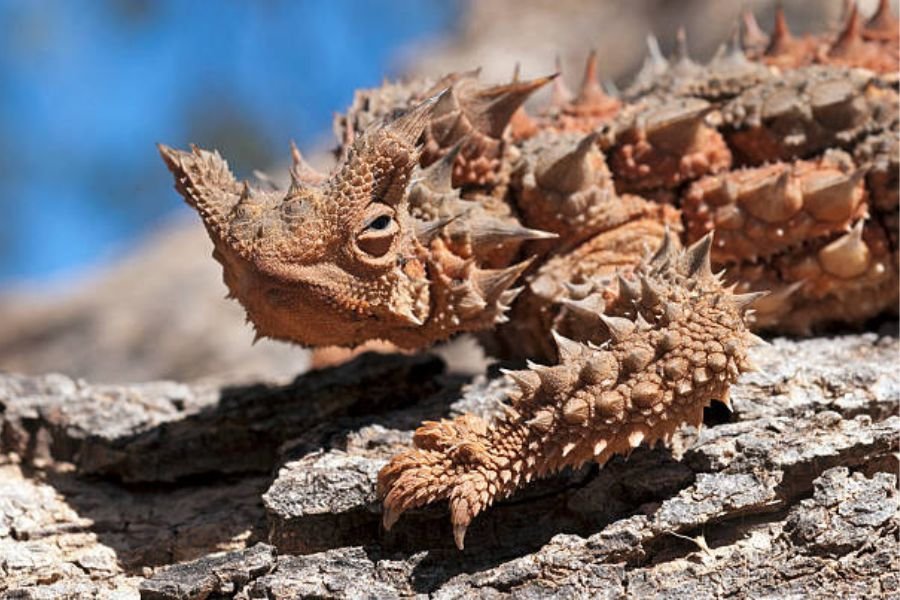
Thorny devil lizard (Moloch horridus)
And since we’re talking about lizards, let’s get to know one more exotic, different, somewhat frightening specimen and, once again, another one from the Australia animals’ list that only naturally live there. The thorny devil lizard, the only species of the genus Moloch (known so far, at least), is a small reptile that feeds exclusively on ants and can drink water through its skin.
The most striking feature of the thorny devil lizard’s appearance is its body covered in spines, which provide it with a powerful form of protection. Despite being scary, it is a small lizard, measuring between 2 and 4 inches long and weighing just over 1.70 ounces. Its lifespan can reach 20 years and it inhabits the desert regions of western Australia.
Curiosity about the thorny devil: its skin covered in scales has a complex process of extracting moisture from the environment. But how does this lizard manage to pull water from the surface of its legs, pass it through its body and take it to its mouth, defying the law of gravity? And by rubbing its belly on damp surfaces, how does the thorny devil manage to extract the water? In your skin, there is a structure of channels that allows capillary action – a phenomenon where water is pulled into narrow spaces, even against the force of gravity. Thus, the skin of the lizard acts like a sponge.

Wombat (Vombatidae)
The wombat is a marsupial, stocky looking, about 3 feet long, and weighing an average of 66 pounds. Its lifespan is 15 years in the wild and 2 years in captivity. There are three known wombat species and all three are of the same size and with very similar features. These are:
- Common Wombat (also known as coarse-haired wombat) (Vombatus ursinus);
- Southern hairy-nosed wombat (Lasiorhinus latifrons);
- Northern hairy-nosed wombat (Lasiorhinus krefftii).
The best known and that won the sympathy of many, with photos and videos spread on the internet is the common wombat. This friendly specimen of endemic Australia animals is herbivorous and has incisor teeth adapted to gnaw rigid vegetation.
As we said, they live naturally only in Australia, but each of the three types is in a specific area: the common wombat inhabits the southeast. The southern hairy-nosed is spread over several areas, preferring semi-arid regions of grasslands, open spaces with bushes and forests, and savannahs. The northern hairy-nosed inhabit the Epping Forest national park. The latter, unfortunately, is classified as critically endangered on the IUCN Red List.
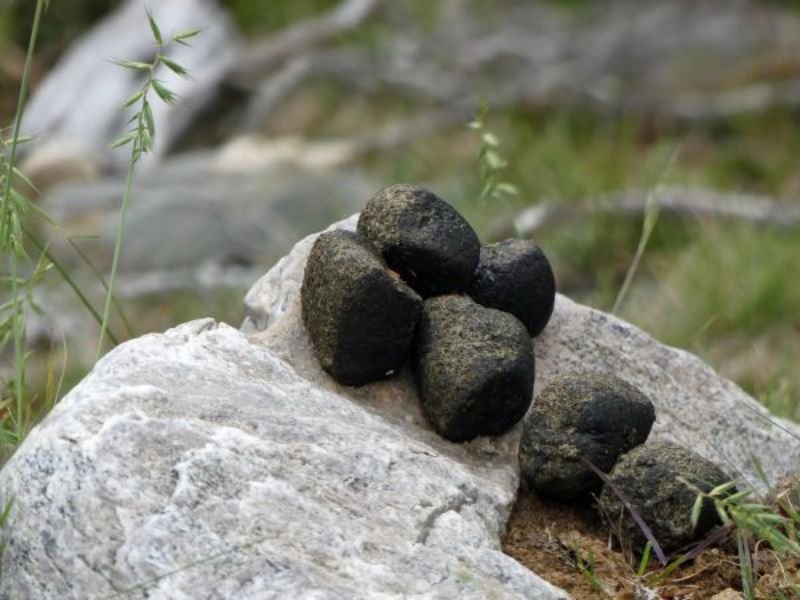
Fun fact about wombats
They are the only animals in nature that poop square. That’s right! There is still no definitive explanation for this fact, but what is speculated, and this is the most accepted and widespread explanation among experts, is that the shape of wombat intestines is responsible for this feat. Cubes are rare in nature. We, humans, shape them. Wombats have another way.

Dingo (Canis lupus dingo or Canis dingo)
Did you imagine that wild dogs still existed? It could even pass for Brazil’s “Caramel” (a type of dog with no identifiable breed), but Dingo, is Australia’s wild dog and the country’s largest land predator. The last of our Australia animals’ list.
Its appearance is very similar to that of the medium and large domestic dogs we know. Its average weight varies between 28 and 77 pounds, and it is between 19 and 24 inches tall. They have short and thick fur, usually in caramel color and golden tones, but you can also see individuals in brown and even white colors.
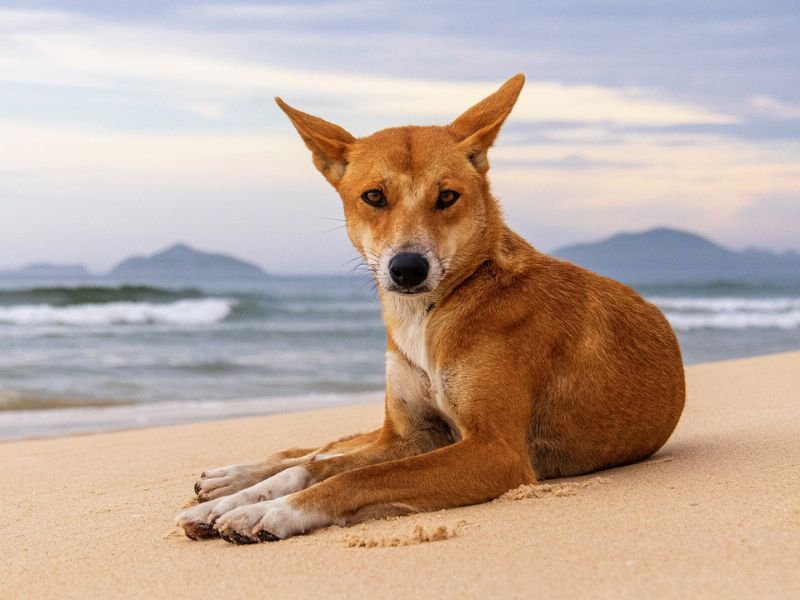
It is an exceptional “dog”, with enviable qualities. Some of them:
- can travel up to 15 miles in a day;
- run up to 38 mph;
- can jump up to 7 feet high;
- climb trees with great ease;
- have a perfect vision;
- rotate their heads up to 180 degrees.
Their food is carnivorous, and yes, they can even eat humans. But most of the time (thankfully), they eat small animals, such as rabbits, lizards, rodents, and birds. They also like fruits and some plants.
Despite being known as “Australia’s wild dog” and being endemic there, the Dingo is not a native species of the country, they were introduced to the continent more than 3 thousand years ago. As a habitat, they occupy different and diverse areas of the country, but mostly deserts, forest edges, and grasslands. They make their burrows in abandoned rabbit holes or fallen tree trunks. Their lifespan in captivity can reach 20 years and in the wild, they live between 5 and 10 years. Unfortunately, the dingo is classified as a vulnerable species.

Curiosity:
Dingo Fence: between 1880 and 1885 the Dingo Fence was built. A fence with more than 3 thousand miles in length (3,488 miles to be exact) whose main objective was to keep the dingoes out of the cattle raising areas. It still exists today and is the largest fence in the world.
This construction divides opinions, because, while it is beneficial for the economy based on livestock, considering that it prevents dingoes from attacking herds, it practically created two separate ecosystems that were once one, and that over time of the years, are increasingly distinct from each other. What is the impact of this on nature?
Conclusion
Did you like to know a little more about the exotic Australia animals? And it was a ‘little bit more’ because we approached only 5 of the many different animals that exist there.
Keep accompanying us, soon we will talk again about incredible Oceania’s fauna.
Until next time! ♥

